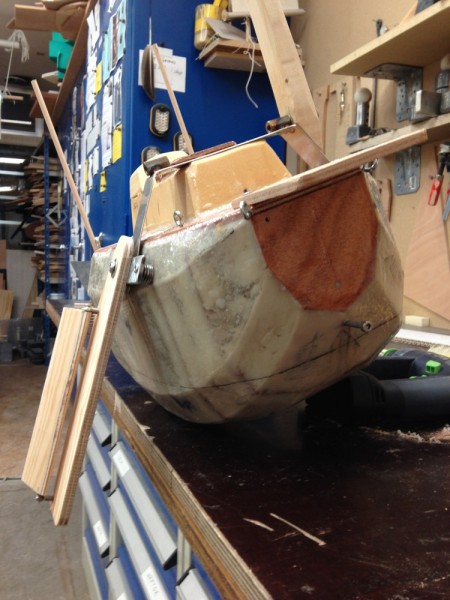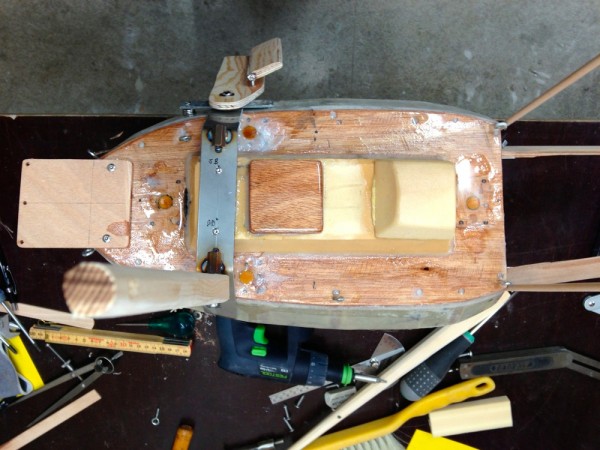Every sailor knows, or ought to know that the force created by the flow over a foil increases with the square of its speed.
If Yrvind Ten would make three knots through the water hard on the wind in ideal conditions I be very happy.
If she will make half a knot in gale conditions I will be equally happy.
The heart of the matter is that the power of the foil to resist leeway has in the gale case been reduced to 2.8 %, very unsatisfactory.
(3 divided by ½ = 6. Six squared equals 36. 1:36 = 2.8 %)
To make things worse the need for lateral force in a gale is much bigger than in nice weather.
Airplanes have a similar problem. During take off, when they travel relatively slow, they need lots of lifting force.
In order to become airborne they employ flaps. That is, the rear portion of the wing rotates downwards. Flaps are high lift devices. They also reduce the stalling speed.
I have decided to use flaps on my leeboards – detachable flaps.
I will have an asymmetrical leeboard on each side, asymmetrical because they are more efficient.
I will use a slotted flap. They allow fluid to pass between the foil and the flap. That way I will have no problem to seal the gap.
I will place the flap not in the same streamline but in the way a jib and main are positioned in relation to each other, with a bit of overlap.
In good conditions the flap will stay on deck because the leeboard itself will be sufficient to prevent leeway. That way drag is reduced.
I only need one flap as I can flip it bottom for top using it on both sides.
When I put the flap on and take it of, the leeboard will be out of water. That way I can easily do the work from the hatch.
In nice weather I increase the sail area and reduce the lateral area. In rough weather I increase lateral area and reduce sail area.
Before I add an object to the boat I ask myself, do this thing earn its keep? In this case I believe it does, for the following reasons. Not many small boats have been cruising the roaring forties and not many people live there. What we know about the weather there comes mostly from big boats. But, big boats are not stationary observers, often they voluntary travel with east moving weather systems. That way they can enjoy and report strong westerly winds for long periods of time.
Compared to bigger boats Yrvind Ten with her speed of about two knots can be considered almost stationary. She will experience completely different weather patterns. She will be exposed to two or three lows each week. When a depression has passed there will often be nice easterly winds – not adding much to the progress. From a stationary observers viewpoint the roaring forties is not a strong trade wind.
To complicate matters there are also strong easterly gales. Once, when I was less experienced I rode one out in comfort to a sea anchor. When the weather had moderated and the sun came out I fixed my position. I had been set back 150 miles.
Some navigators may think that’s a good deal, not me. My present boat will hopefully be able to fight gales head on. The new strategy to deal with contrary gales is to dig in, to hold on stubbornly – at the risk of being capsized – until the wind swings over to a more favorable quarter, then I will ease the sheets and run.
Slotted flaps are high lift devices. They reduce the stalling speed. I am betting on that they will earn their keep.
However one must not forget that in stormy conditions flow around foils is very turbulent. One reason for that is the circular movement of the water particles in a wave. At the top of the wave they move in the same direction as the wind at the trough in the opposite. In a gale the speed difference is often more than six knots, a speed far higher than Yrvind Tens. Accordingly, theoretically, the flow around the foils will vary as a sine curve, sometimes being positive, sometimes negative.
In reality turbulence will create much chaos. Then only a lot of lateral surface prevents leeway, a bit like a parachute. So in stormy conditions Yrvind Ten needs all the lateral area she can get. The slotted flap will not only increase lifting force when there is flow, it will also at the same time increase lateral area. The leeboards itself are already as big as I dare to make them.
Below are some pictures. Click once or twice to enlarge.
Above the slotted flap.
The flap laying on deck.
Slotted flap on healead boat. Front vieuw.
Top vieuw.
To be continued…
Regards Yrvind.




